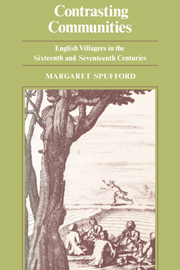Book contents
- Frontmatter
- Contents
- List of maps and graphs
- List of tables
- List of abbreviations
- Acknowledgements
- Dedication
- Introduction
- Map 1 Cambridgeshire: natural boundaries and soil types
- Map 2 Cambridgeshire: county and parish boundaries
- PART 1 People, Families and Land
- PART 2 The Schooling of the Peasantry
- PART 3 Parishioners and their Religion
- Conclusion
- Appendix 1 The Butlers of Orwell
- Appendix 2 Notes on Graphs 3 and 5
- Index of Contemporary Names
- General Index
- Frontmatter
- Contents
- List of maps and graphs
- List of tables
- List of abbreviations
- Acknowledgements
- Dedication
- Introduction
- Map 1 Cambridgeshire: natural boundaries and soil types
- Map 2 Cambridgeshire: county and parish boundaries
- PART 1 People, Families and Land
- PART 2 The Schooling of the Peasantry
- PART 3 Parishioners and their Religion
- Conclusion
- Appendix 1 The Butlers of Orwell
- Appendix 2 Notes on Graphs 3 and 5
- Index of Contemporary Names
- General Index
Summary
Dissent and separatism were strong and firmly rooted in three groups of Cambridgeshire parishes after the restoration. Although these were parishes where Congregationalism Baptist and Quaker evangelists had worked during the commonwealth, their work was not responsible for the existence of the Puritan state of mind amongst the laity that could lead to separatism; they were responsible for fostering, directing and spreading it, but not for initiating it. The existence of large numbers of parishioners in 1640, anxious to be rid of episcopal government and set up ‘government according to the scriptures’, concentrated in exactly the same areas as in 1676, demonstrates this very clearly. The fact that only a fifth of these petitioners were wealthy enough to appear in taxation lists brings home with even more force the fact that Puritan religious convictions were, in this county, a grass-roots phenomenon amongst the very humble, which pre-dated the commonwealth. A certain amount more flesh is put on these bare bones by the numbers of husbandmen and labourers with ‘tender consciences’, who were found to present articles against the Laudian or royalist clergy.
A considerable number of Cambridgeshire villages were anti-Laudian or even anti-episcopal in the 1630s. But we cannot take the history of their convictions back, and prove that, as the post-restoration Congregationalists had it, there was a body of ‘old Brownists’ in the diocese.
- Type
- Chapter
- Information
- Contrasting CommunitiesEnglish Villages in the Sixteenth and Seventeenth Centuries, pp. 351 - 353Publisher: Cambridge University PressPrint publication year: 1974



